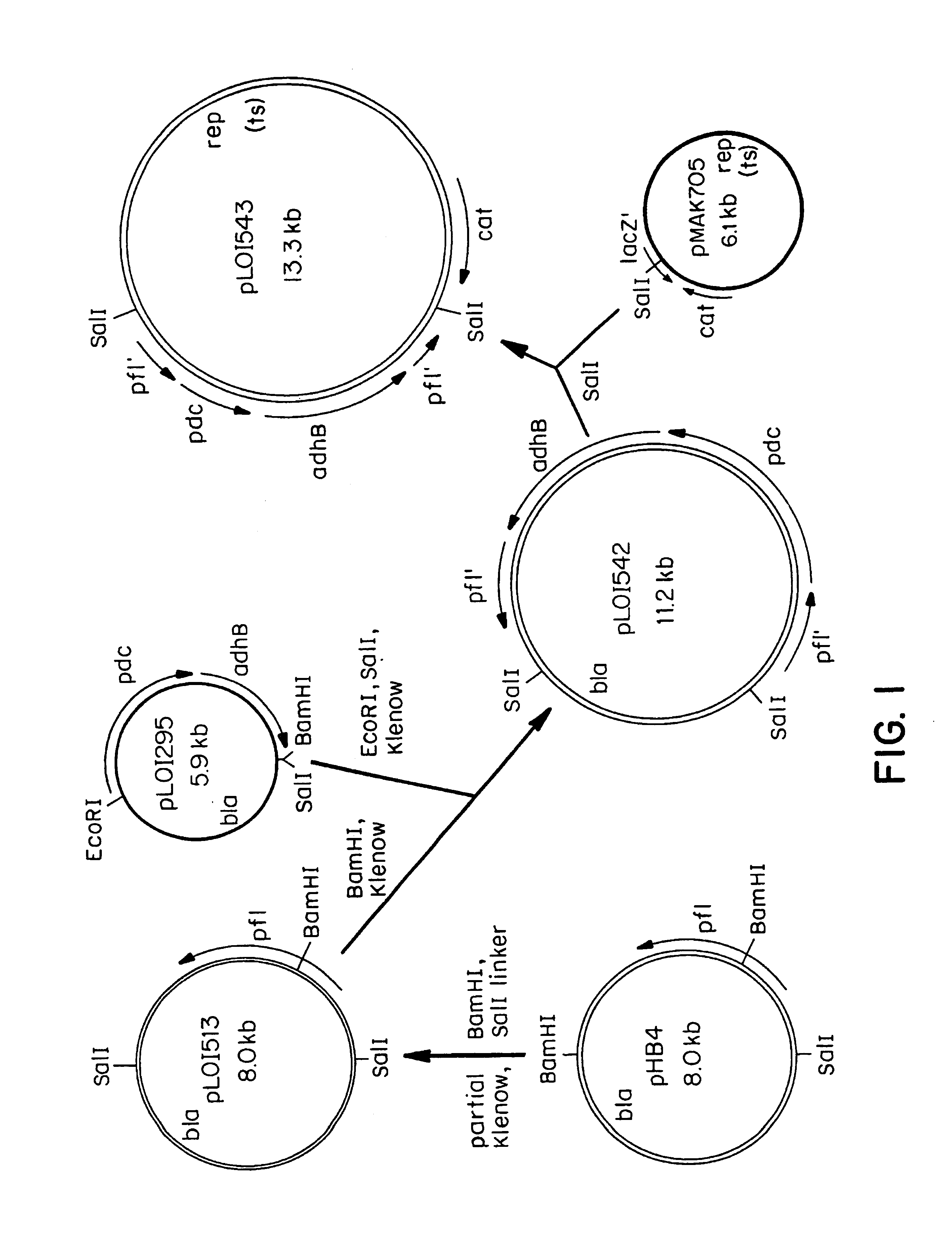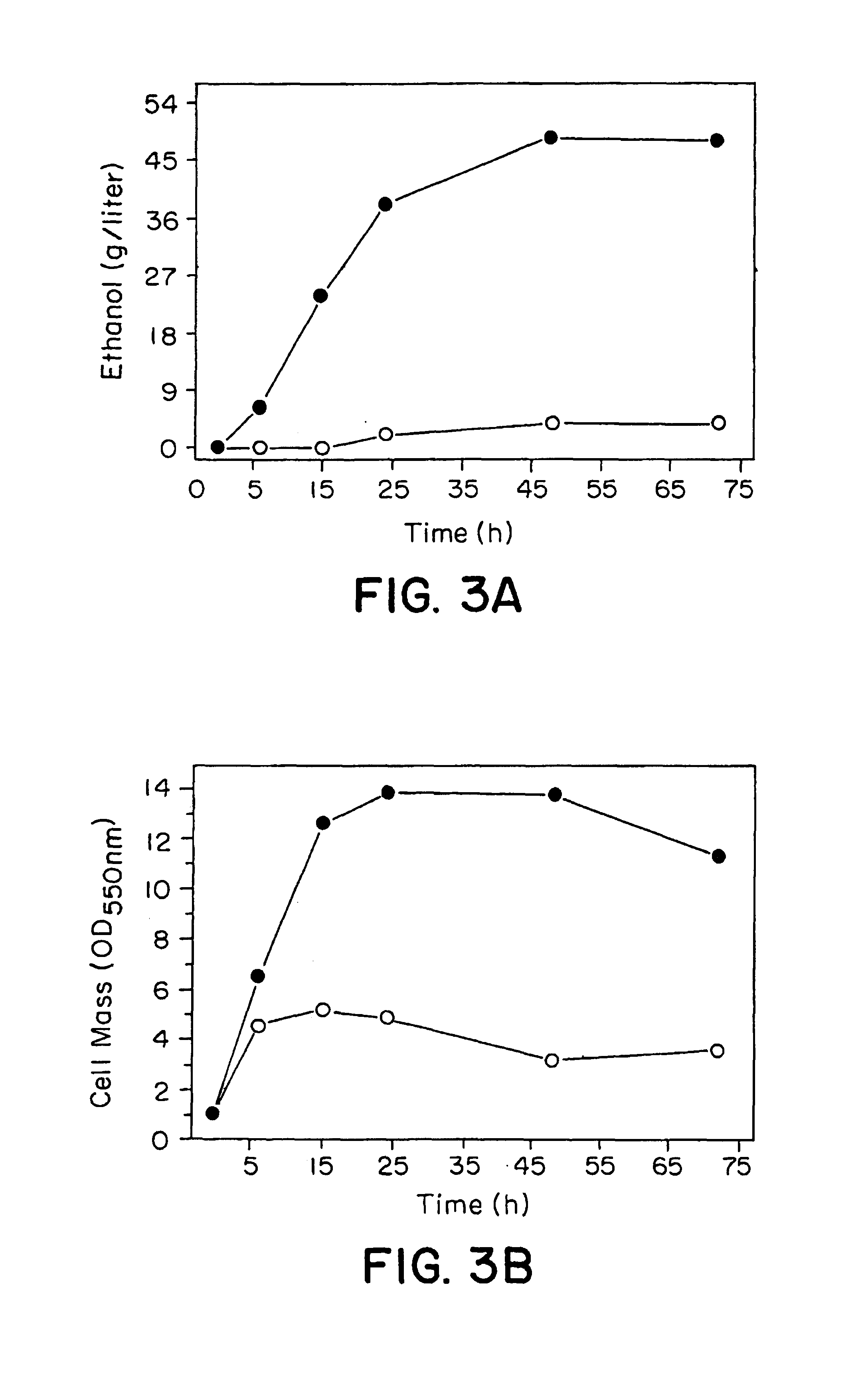Recombinant cells that highly express chromosomally-integrated heterologous gene
a heterologous gene and recombinant cell technology, applied in the field of recombinant host cells, can solve the problems of inefficient utilization of expensive sugar substrates, relatively expensive sources of biomass sugars, and become more toxic upon accumulation, so as to reduce the production of acid, impair the recombination in the cell, and reduce the production of succinate.
- Summary
- Abstract
- Description
- Claims
- Application Information
AI Technical Summary
Benefits of technology
Problems solved by technology
Method used
Image
Examples
example 1
Construction of Integration Plasmids Containing E. coli Pyruvate Formate-lyase Gene
[0100]The following materials and methods were used throughout the present examples unless otherwise stated. E. coli TC4 was used for all genetic constructions. See Conway, T., Y. A. Osman, J. I. Konnan, E. M. Hoffman, and L. O. Ingram [1987] J. Bacteriol. 169: 949-954. Luria broth containing the appropriate selective antibiotic and the indicated concentrations of glucose was used in all growth experiments. Antibiotics were used in the following final concentrations except as noted: ampicillin, 50 μg / ml; chloramphenicol (Cm), 20 μg / ml or 600 μg / ml, as indicated; tetracycline, 12.5 μg / ml. ADH indicator plates containing the Schiff reagent were used to detect aldehyde produced from ethanol by recombinant E. coli expressing ADHII of Z. mobilis. Conway, T., G. W. Sewell, Y. A. Osman, and L. O. Ingram [1987] J. Bacteriol. 169: 2591-2597.
[0101]Standard procedures were used for plasmid preparation, restricti...
example 2
Construction of Integration Plasmids Containing E. coli Pyruvate Formate-lyase Gene and Temperature-sensitive for Plasmid Replication
[0104]Plasmid pLOI295 was digested with EcoRI and SalI, and the 3.2-kb EcoRI-SalI fragment carrying pdc and adhB genes was treated with Klenow fragment of DNA polymerase to produce blunt ends. This blunt-ended fragment was ligated into the Klenow-treated BamHI site of pLOI513 carrying the incomplete pfl gene in the same orientation with respect to transcription to give pLOI542. pLOI542 was then digested with SalI and the 7.2-kb SalI fragment was ligated to SalI site in the polylinker of pMAK705, see Hamilton, C. M., M. Aldea, B. K. Washburn, P. Babitzke, and S. R. Kushner [1989] J. Bacteriol. 171: 4617-4622, containing the temperature-sensitive replicon and Cmr gene (FIG. 2). The resultant plasmid pLOI543 was introduced into the E. coli chromosome by homologous recombination (see Example 3 below).
example 3
Chromosomal Integration in E. coli B of Z. mobilis pdc and adhB Genes with Loss of an Associated Antibiotic Resistance Gene
[0105]The recombinant plasmid pLOI543, which replicates at 30° C., but not at 44° C., was used to transform E. coli B with the Cmr gene to give it resistance to chloremphenicol. Transformed cells were grown at 44° C. in 100 ml Luria broth containing 20 μg / ml chloramphenicol and 5% (w / v) glucose for 24 hours to select for integration of the plasmid into the chromosome. A portion (0.1 ml) of this culture was diluted, and 0.1 ml of the diluted cell suspension was used to inoculate 100 ml of Luria broth containing 5% (w / v) glucose without chloramphenicol. The culture was grown at 30° C. for 12 hours to allow excision. Two or more cycles of growth were carried out by diluting a portion (0.1 ml) of the culture and inoculating into 100 ml of fresh medium. A diluted cell suspension of the 12-hour culture was then used to inoculate Luria broth containing 5% (w / v) glucose...
PUM
| Property | Measurement | Unit |
|---|---|---|
| Fraction | aaaaa | aaaaa |
| Density | aaaaa | aaaaa |
| Temperature | aaaaa | aaaaa |
Abstract
Description
Claims
Application Information
 Login to View More
Login to View More - R&D
- Intellectual Property
- Life Sciences
- Materials
- Tech Scout
- Unparalleled Data Quality
- Higher Quality Content
- 60% Fewer Hallucinations
Browse by: Latest US Patents, China's latest patents, Technical Efficacy Thesaurus, Application Domain, Technology Topic, Popular Technical Reports.
© 2025 PatSnap. All rights reserved.Legal|Privacy policy|Modern Slavery Act Transparency Statement|Sitemap|About US| Contact US: help@patsnap.com



